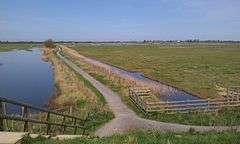RSPB Frampton Marsh
Frampton Marsh is a nature reserve in Lincolnshire, England. The reserve is situated on the coast of The Wash, some 4 miles from the town of Boston, between the outfalls of the Rivers Welland and Witham (covering an area of mature salt marsh known as The Scalp), and near the village of Frampton. Most of the reserve is managed by the RSPB with part managed by the Lincolnshire Wildlife Trust. There is a small visitor centre at the entrance to the reserve.
| RSPB Frampton Marsh | |
|---|---|
 | |
 | |
| Location | Frampton, Lincolnshire, England |
| Coordinates | 52.9263°N 0.0266°E |
| Area | 172 hectares (430 acres) |
| Operated by | |
| Website | www |
History
The majority of the site was purchased by the RSPB in 1984, but it was not until 2007, when arable farmland inland of the sea bank was purchased, that the wetland creation project began.[1]
Fauna and flora
Birds
Thousands of migrating birds gather at Frampton Marsh. Species which can be regularly observed here include pied avocet, common redshank and curlew. The reserve frequently sees nationally rare bird species appear, the majority of which are rare waders. These have included a black-winged stilt, broad-billed sandpiper and Wilson's phalarope during 2015[2] and a lesser yellowlegs during 2014.[3]
References
- "The making of Frampton Marsh". Lincolnshire Life. Retrieved 7 July 2020.
- Hudson, Nigel. "Report on rare birds in Great Britain in 2015" (PDF). British Birds. Retrieved 7 July 2020.
- Hudson, Nigel. "Report on rare birds in Great Britain in 2014" (PDF). British Birds. Retrieved 7 July 2020.